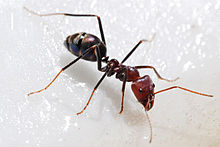虹琉璃蚁属
来自维基百科,自由的百科全书
虹琉璃蚁属(Iridomyrmex),俗名彩虹蚁(rainbow ant, 因其带有蓝绿色彩虹光泽),隶属于蚁科琉璃蚁亚科,由澳洲昆虫学家古斯塔夫·迈尔 (Gustav Mayr) 于1862年首次描述,现生有79种,已灭绝有5种,大部分物种原生于澳洲,其余的原生于亚洲及大洋洲,它们也被人为引入巴西、新西兰及阿拉伯地区。已灭绝的物种分布于中国、法国及美国。
它们是优势种,它们会扰乱土壤组成或进入屋中,所以有时候被当成害虫。澳洲的农夫会利用肉蚁(I. purpureus)来清除动物尸体,将尸体放在蚁丘上,数周内就会只剩下骨头。肉蚁会进行仪式性(ritualised)的打斗,以解决不同群体间的领地冲突,这种方式可以减少伤亡。本属最大的物种是 I. purpureus 物种复合群(species group),体长约8毫米。
蚁后在婚飞后会建立新的群体,可以是单独进行,或是透过分巢,也就是一些母群体的工蚁偕同蚁后一起迁徙到新的地点,有时候数只蚁后会合作筑巢,但在工蚁羽化后便会互相攻击,最后只会剩下一只蚁后。卵羽化成工蚁需花费44到61天。虹琉璃蚁习性及栖地多样,因物种而异,有些物种筑巢于土壤中,群体大小从数百个体到超过三十万个体,巢体样式可以是被卵石覆盖,有好几个出入口的大型蚁丘,有些物种在枝条中筑巢,有些物种则会建立数个蚁巢,并以通道相连,蚁巢群的长度甚至可以达到650米;有些物种会和其他生物共生,像是会提供蚂蚁分泌物或蜜露的鳞翅目幼虫;I. bicknelli 会替兰花授粉;虹琉璃蚁是掠食者也是清除者,会捕食猎物喂养幼虫;虹琉璃蚁免疫海蟾蜍的毒素,能够猎食未成熟的海蟾蜍;虹琉璃蚁的猎食者有蜘蛛、鸟类、蜥蜴或其他蚂蚁。
系统发生学
虹琉璃蚁属与最近的祖先约在1200万年前分化[3],虽然虹琉璃蚁属与其姊妹群 Froggattella 属所历经的时间相同[4],但 Froggattella 属只有2个物种,相较于其他印澳地区的属,该支系较为年轻,琉璃蚁亚科约在2300万年前分化,虹琉璃蚁属的化石分布于使新世及寡新世[5]。以下为虹琉璃蚁属在印澳地区琉璃蚁亚科的属的系统发生地位[3]。
| Indo‑Australian genera |
| |||||||||||||||||||||||||||||||||||||||||||||||||||
分类学
虹琉璃蚁属由澳洲昆虫学家 Gustav Mayr 于1862年首次描述[6],但直到1903年才指定模式种[4],模式种为 Formica detecta,Iridomyrmex purpureus 的同物异名[7][8],1878年琉璃蚁亚科建立之后虹琉璃蚁属被分类到其下[9],虹琉璃蚁属的分类早期错综复杂,因为早期的研究者没有辨认出虹琉璃蚁属的关键特征,因此把很多物种错置于虹琉璃蚁属下[4][10]。
蚂蚁学家 William Brown 二世是第一个质疑虹琉璃蚁属并非单系群的人[4],他指出阿根廷蚁(旧时隶属虹琉璃蚁属)和其他虹琉璃蚁属物种的相异之处[11]。虹琉璃蚁属首次重整是在1990年代,其下的91个物种被重新分配到了6个属,分别是Anonychomyrma 属、Doleromyrma 属、Linepithema 属、Ochetellus 属、Papyrius 属和 Philidris 属 ,重整后只有62个物种仍隶属虹琉璃蚁属[4],2011年,虹琉璃蚁属再次重整,第二次重整后,虹琉璃蚁属现在包含79个现生物种及5个已灭绝物种,其中有31个是新发表的物种[4],4个物种被分配到其他属之下,25个物种及亚种被归类为同物异名。根据单篇资料来源指出,澳洲虹琉璃蚁属的物种可能有350种[12]。
虹琉璃蚁属的学名:Iridomyrmex ,意思是彩虹般的蚂蚁,因其蓝绿色的彩虹光泽而得名[13],Irido 为古希腊文,意思是彩虹[14];myrmex ,也是古希腊文,意思是蚂蚁[15]。
(已灭绝物种以 † 标示)
- Iridomyrmex adstringatus Heterick & Shattuck, 2011
- Iridomyrmex agilis Forel, 1907
- Iridomyrmex alpinus Heterick & Shattuck, 2011
- Iridomyrmex anceps (Roger, 1863)
- Iridomyrmex anderseni Shattuck, 1993
- Iridomyrmex angusticeps Forel, 1901
- Iridomyrmex anteroinclinus Shattuck, 1993
- Iridomyrmex atypicus Heterick & Shattuck, 2011
- Iridomyrmex azureus Viehmeyer, 1914
- Iridomyrmex bicknelli Emery, 1898
- Iridomyrmex bigi Shattuck, 1993
- Iridomyrmex brennani Heterick & Shattuck, 2011
- †Iridomyrmex breviantennis Théobald, 1937
- Iridomyrmex brunneus Forel, 1902
- Iridomyrmex calvus Emery, 1914
- Iridomyrmex cappoinclinus Shattuck, 1993
- Iridomyrmex cephaloinclinus Shattuck, 1993
- Iridomyrmex chasei Forel, 1902
- Iridomyrmex coeruleus Heterick & Shattuck, 2011
- Iridomyrmex conifer Forel, 1902
- Iridomyrmex continentis Forel, 1907
- Iridomyrmex cuneiceps Heterick & Shattuck, 2011
- Iridomyrmex cupreus Heterick & Shattuck, 2011
- Iridomyrmex curvifrons Heterick & Shattuck, 2011
- Iridomyrmex cyaneus Wheeler, 1915
- Iridomyrmex difficilis Heterick & Shattuck, 2011
- Iridomyrmex discors Forel, 1902
- Iridomyrmex dromus Clark, 1938
- Iridomyrmex elongatus Heterick & Shattuck, 2011
- Iridomyrmex exsanguis Forel, 1907
- †Iridomyrmex florissantius Carpenter, 1930
- Iridomyrmex fulgens Heterick & Shattuck, 2011
- Iridomyrmex galbanus Shattuck, 1993
- Iridomyrmex gibbus Heterick & Shattuck, 2011
- Iridomyrmex gumnos Heterick & Shattuck, 2011
- Iridomyrmex hartmeyeri Forel, 1907
- Iridomyrmex hertogi Heterick & Shattuck, 2011
- Iridomyrmex hesperus Shattuck, 1993
- Iridomyrmex infuscus Heterick & Shattuck, 2011
- Iridomyrmex innocens Forel, 1907
- Iridomyrmex lividus Shattuck, 1993
- Iridomyrmex longisoma Heterick & Shattuck, 2011
- Iridomyrmex luteoclypeatus Heterick & Shattuck, 2011
- Iridomyrmex macrops Heterick & Shattuck, 2011
- †Iridomyrmex mapesi Wilson, 1985
- Iridomyrmex mattiroloi Emery, 1898
- Iridomyrmex mayri Forel, 1915
- Iridomyrmex meridianus Heterick & Shattuck, 2011
- Iridomyrmex minor Forel, 1915
- Iridomyrmex mirabilis Heterick & Shattuck, 2011
- Iridomyrmex mjobergi Forel, 1915
- Iridomyrmex neocaledonica Heterick & Shattuck, 2011
- Iridomyrmex niger Heterick & Shattuck, 2011
- Iridomyrmex nudipes Heterick & Shattuck, 2011
- †Iridomyrmex obscurans Carpenter, 1930
- Iridomyrmex obscurior Forel, 1902
- Iridomyrmex obsidianus Emery, 1914
- Iridomyrmex omalonotus Heterick & Shattuck, 2011
- Iridomyrmex pallidus Forel, 1901
- Iridomyrmex phillipensis Heterick & Shattuck, 2011
- Iridomyrmex prismatis Shattuck, 1993
- Iridomyrmex purpureus (Smith, 1858)
- Iridomyrmex reburrus Shattuck, 1993
- Iridomyrmex roseatus Heterick & Shattuck, 2011
- Iridomyrmex rubriceps Forel, 1902
- Iridomyrmex rufoinclinus Shattuck, 1993
- Iridomyrmex rufoniger (Lowne, 1865)
- Iridomyrmex sanguineus Forel, 1910
- Iridomyrmex setoconus Shattuck & McMillan, 1998
- †Iridomyrmex shandongicus Zhang, 1989
- Iridomyrmex spadius Shattuck, 1993
- Iridomyrmex splendens Forel, 1907
- Iridomyrmex spodipilus Shattuck, 1993
- Iridomyrmex spurcus Wheeler, 1915
- Iridomyrmex suchieri Forel, 1907
- Iridomyrmex suchieroides Heterick & Shattuck, 2011
- Iridomyrmex tenebrans Heterick & Shattuck, 2011
- Iridomyrmex tenuiceps Heterick & Shattuck, 2011
- Iridomyrmex trigonoceps Heterick & Shattuck, 2011
- Iridomyrmex turbineus Shattuck & McMillan, 1998
- Iridomyrmex victorianus Forel, 1902
- Iridomyrmex viridiaeneus Viehmeyer, 1914
- Iridomyrmex viridigaster Clark, 1941
- Iridomyrmex xanthocoxa Heterick & Shattuck, 2011
描述
虹琉璃蚁属不同于其他琉璃蚁亚科的物种,虹琉璃蚁属的头楯前缘高于大颚;眼睛位于头部的最上方,远离大颚[4][16],虹琉璃蚁属为中小型物种:I. conifer 物种复合群的物种体长约为4毫米,体色红棕色,前伸腹板明显突出;I. purpureus 物种复合群的物种体型最大,体长约为8毫米[17]。
虹琉璃蚁属物种的工蚁罕有多形性[4]。
观察结果显示,畸形的工蚁存在于自然环境中,例如以下案例,有只工蚁的前伸腹节与腹垂节愈合,虽然腹柄节存在,但却异常增大,尽管畸形导致一点阻碍,该工蚁仍有活动能力[18]。
分布地区及栖地

虹琉璃蚁属的物种分布在许多国家和岛屿,范围横跨好几个大陆,在大洋洲地区分布于斐济、印尼、新多里喀尼亚、巴布亚新几内亚和所罗门群岛[4][19][20];澳洲的每个州都有分布[21];新西兰则是被人为引入,分布于北岛及南岛[22];在亚洲则分布于缅甸、东帝汶、印度、马来西亚和菲律宾[4][23]。唯一分布于中东地区的物种是 I. anceps ,被人为引入阿拉伯联合酋长国;I. rufoniger 被人为引入巴西[4][24];大洋洲的诺福克岛和菲律普岛也有族群[4]。已灭绝物种的分布范围大于现生的分布范围,中国、法国和美国都曾出土过虹琉璃蚁的化石[25][26][27]。

虹琉璃蚁栖息在市郊,干燥和半干燥地区, 栖息于相思树、贝壳杉、班库树、木麻黄、桉树等林地中,也栖息于牧场、澳洲柏森林、都市公园、农地、草原、石楠树林地、沙丘、稀树草原、沼泽、都市花园、潮湿雨林、硬叶林,或是人造建物。
虹琉璃蚁大部分会在土壤中筑巢,但有些也会住在石头下、朽木中,甚至是沙滩、人行道中[4],某些物种会避免在沙质土壤中筑巢[28],巢体外观多变,大部分是具有单个出入口的小型蚁丘,有些物种的巢体则是被卵石覆盖且具有多个出入口的大型蚁丘[4],某些物种会筑出超级巢体,数个巢体彼此透过通道相连,长度可达650米[16],曾经有个案例,有个群体占据了超过10公顷的地,总共有85个巢体和1500个出入口[29]。肉蚁不会攻击巢友,但是会攻击居住在不同巢体但同一群体的个体[30]。巢体可以是高于地表或低于地表,有些物种如 I. conifer 高于或低于地表的巢都有,冬天时它们会筑巢于树枝上,天气回暖时栖息在地下[16],地下巢筑在食物充足的地区,冬天时群体会移居到阳光充足的地方[31]。
行为和生态学

大部分的虹琉璃蚁习性凶悍,会主动攻击骚扰巢穴或是觅食时遇到的生物,特别是 I. purpureus 物种复合群的物种,它们会涌出巢穴杀死入侵者[4];小型的物种也很凶悍,它们会喷洒虹琉璃蚁素(iridomyrmecin),一种虹琉璃蚁属专有的防御物质[4],虹琉璃蚁数量大,生性凶悍,活动力强,在澳洲是优势种,某些物种会占据资源,阻止其他昆虫前来取食[32],它们数量多又活跃,甚至能影响其他蚂蚁的觅食行为[4]。
虽然虹琉璃蚁以凶悍著名,有些物种生性胆小,遭到骚扰只会逃离或躲藏,也会避免和其他蚂蚁接触[4];如果巢穴受到攻击,它们不会反击,而是把幼虫搬走,然后什么也不做,它们会躲在落叶里或植物里,有些物种如 I. victorianus 遭受威胁时会静止不动[4]。
当邻近的肉蚁群体发生领地冲突时,它们会透过仪式性的打斗来解决纷争[33][34],不同群体的个体相遇时,它们会快速地挥动触角,张开大颚,尽可能的张开身体让自己看起来更高更大,这行为暗示着肉蚁的打斗是透过比较体型进行[34],打斗结束后,它们会清洁自己的身体,继续寻找下一只蚂蚁[33],有些群体间的冲突可以持续数月甚至数年,但是真正会导致严重伤亡的打斗极为罕见。
虹琉璃蚁是猎食者和清除者,它们也会和半翅目及鳞翅目幼虫互动以取得蜜露[4],它们会猎食小型昆虫,取食花粉[4],它们通常在地面上觅食,但大多数物种还会爬到植株上觅食;虹琉璃蚁大多数活动于昼夜,但有些是夜行性[4],它们白天时会堵住出入口,如果天气合适,有些夜行性的物种也会在白天活动,但是有些物种,如 I. bigi 无论如何都不会在白天活动;有些物种会筑巢在没有阴影的地方,日出之后他们就可以晒太阳暖活身子,然后开始觅食[35]。

虹琉璃蚁主要取食甜食,如花粉及蜜露[4],工蚁会猎食昆虫或其他蚂蚁来喂食幼虫[16],工蚁会被长有油质体的种子吸引,它们会收集种子,剥下油质体后丢弃种子,这些留在蚂蚁附近的种子拥有较高的存活率[5]。
它们有时候会在白蚁丘里筑巢[36],如此它们就可以就近捕食白蚁,除了捕食以外,目前没有任何证据显示白蚁和蚂蚁有任何交互作用[4],有些免疫海蟾蜍毒素的物种会捕食未成年的海蟾蜍[37],如 I. purpureus 和 I. ruburrus[38][39],由于此特性,有人提议在海蟾蜍栖地释放虹琉璃蚁巢,以达到生物防治的目的。
肉蚁是澳洲唯一会取食海鸟粪的蚂蚁[40]。
有些无脊椎动物专食虹琉璃蚁: 游走蛛(Habronestes bradleyi) 会追踪它们的紧戒费洛蒙[41][42][43][44];澳洲多刺魔蜥(Moloch horridus)是伏击型的猎食者,专食虹琉璃蚁属的物种,它们甚至会专食特定单一物种,拒食同属其他物种[45];盲蛇 Ramphotyphlops nigrescens 会追踪它们的行经的路径,取食部分物种的幼虫和卵[46];有些地甲虫会躲在蚁巢附近的土中,捕食经过的工蚁[47]。
短吻针鼹(Tachyglossus aculeatus)会在婚飞期间捕食高脂肪含量的处女蚁后[48],它们也会在八月到十月攻击蚁巢,捕食巢中的繁殖型个体[49],蚁后在婚飞期后仍然处于危险之中,因为有些鸟,如澳洲喜鹊、渡鸦,会被刚翻过的土壤吸引,它们会翻开土壤捕食那些刚建立新群体的蚁后[50];寄生性的绦虫也会感染虹琉璃蚁[51]。

在温带潮湿气候区,它们全年都会婚飞[4],婚飞进行时,繁殖蚁会离开巢穴爬到高处,准备起飞和交配[4],蚁后会和单只或多只雄蚁交配,因物种而异[52];根据观察结果,肉蚁是雄蚁先起飞再来才是蚁后[50];20至40只蚁后会聚集到巢穴的顶端,并在身体暖活后起飞,这个周期一天内会持续数次,并且维持数天,直到气候改变或是巢中没有任何蚁后[50],雄蚁在交配之后就会死去,蚁后则会寻找适合的地方建立群体,寻找的过程中它们会暴露在鸟类或其他猎食者的威胁之中[53],也会因为各种原因,如疾病或饥饿导致死亡[50];大多数的蚁后独自筑巢,但也可以是多个蚁后合作筑巢、被其他群体纳入巢中,或是“分巢”,也就是母群体的一部分离开旧巢建立新巢[54]。10%的蚁后会和其他蚁后合作筑巢[55]。

蚁后掘出巢室后会产下大约20颗卵,它们会在一个月内孵化,卵羽化成成虫需花费44到61天[54][56];成熟巢穴个体数各异,从数百到30万以上不等[5][57],大多数的群体是单后型,但也有多达四只蚁后的群体[50][58],寡后型(Oligogynous)的群体也存在,巢中存在多个蚁后,蚁后间彼此争夺产权,但不同蚁后产下的工蚁不会攻击不同的蚁后[54][59],蚁后只会照顾自己的卵幼[58][60],群体成长到一定规模后,蚁后就不会继续聚集[54][61]。
共生生物

虹琉璃蚁会和鳞翅目幼虫、蚜虫及介壳虫共生[16][62][63],工蚁会保护鳞翅目幼虫,有时候还会把它们搬入巢中[16]。会和虹琉璃蚁共生的鳞翅目包含佳灰蝶(Jalmenus clementi、Jalmenus daemeli、Jalmenus eichhorni、Jalmenus evagoras、Jalmenus icilius、Jalmenus inous、Jalmenus lithochroa)[64]:246–248 [65]、澳灰蝶(Ogyris amaryllis、Ogyris olane、Ogyris oroetes)[64]:234–236、灰尖角灰蝶(Anthene lycaenoides)[64]:270、希特坎灰蝶(Candalides heathi)[64]:266、Candalides margarita (trident pencil-blue), Deudorix diovis (bright cornelian),[64]:256–258 Euchrysops cnejus (gram blue),[64]:290 Lampides boeticus (pea blue),[64]:290 Leptotes plinius (plumbago blue),[64]:288 Lucia limbaria (chequered copper),[64]:214 Nesolycaena caesia (Kimberly spotted opal),[64]:214 Neolucia agricola (fringed heath-blue)[64]:280 and Theclinesthes serpentata (saltbush blue).[64]:288 。I. bicknelli 会替 Microtis parviflora 授粉[66],且研究指出蚂蚁不会伤害花粉[67]。
肉蚁会在清晨时用卵石和沙土堵住 Camponotus consobrinus 的巢穴出入口,阻挡它们离开巢穴,遭到这种对待的蚂蚁也会回击,用植物纤维堵住肉蚁的巢穴出入口[68][69];如果肉蚁的巢穴被树木或其他阴影盖住,由于照晒不到阳光,群体的健康状况会恶化[70],Camponotus consobrinus 就会入侵肉蚁的巢穴,用一种黑色的树脂类物质堵住通道,受攻击的肉蚁群体会搬到其他的地方[71]。
与人类的互动
在澳洲郊外,肉蚁是农夫不可或缺的帮手,农夫会把动物尸体放到肉蚁巢上,数周内,尸体会被吃到剩骨头[72];虹琉璃蚁有时候也是害虫,它们会进到屋中,取食人类的食物[73],还会翻动土壤扰乱土质[74],清除蚁巢很困难,因为如果没有彻底清除,来自邻近群体的个体会补充待清除蚁巢的个体数[75];有些物种在都市地区适应良好;在堪培拉早期,人为活动影响环境,改变后的植被与花园提供了食物来源[76],于是肉蚁数量快速成长。肉蚁会造成阻碍生物防治半翅目昆虫,特别是那些会分泌蜜露的,进而造成柑橘种植者的困扰[77]。
延伸阅读
- List of ants of Australia
参考文献
外部链接
Wikiwand - on
Seamless Wikipedia browsing. On steroids.

